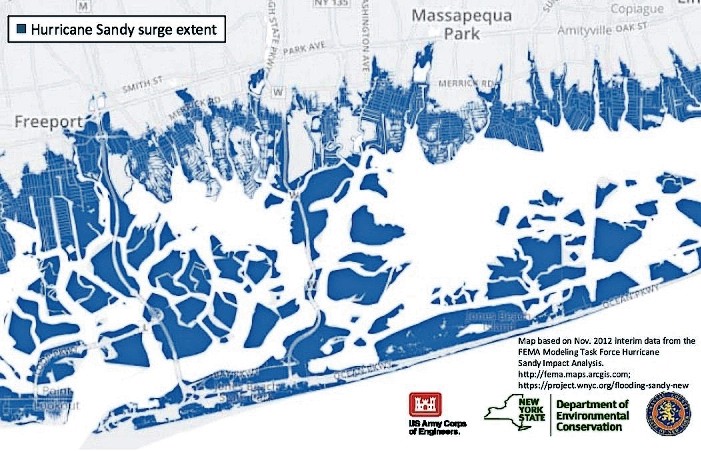Army Corps to study back bays
Officials are seeking solutions to coastal flooding
The South Shore faces an increased risk of natural hazards — including erosion, coastal wave action, storm surge, floods and severe winds — caused by coastal storms, explained Clifford Jones, chief of the New York District U.S. Army Corps of Engineers’ planning division, to a crowd of residents at Seaford High School last week.
Jones said that many densely developed areas in Nassau County have low elevation, causing them to flood during high tides and storms. The USACE is investigating potential solutions. In partnership with the State Department of Environmental Conservation and Nassau County, the corps invited residents to learn about the “Nassau County Back Bays, NY Coastal Storm Risk Management Feasibility Study” at two community meetings, called “scoping sessions,” where they could voice concerns about flooding. These were held at Seaford High School on May 2 and at Freeport Village Hall on May 3.
The three-year feasibility study was launched in September 2016 with the goal of recommending a plan to Congress for coastal storm risk management for communities at risk along the bay shorelines, according to Danielle Tommaso, a project planner.
After Hurricane Sandy, Congress passed Public Law 113-2, which authorized funding to federal agencies for expenses that were a consequence of the storm. To support this goal, the USACE completed the North Atlantic Coast Comprehensive Study, which named nine high-risk areas on the Atlantic Coast. The Nassau back bays — Hewlett Bay, Middle Bay, Jones Bay, South Oyster Bay and associated creeks, channels and minor water bodies — were identified as high-risk regions that warranted an in-depth investigation, according to County Executive Ed Mangano.
Tommaso said that the feasibility study’s purpose is to structure a nine-step plan to reduce flood risk. In the first phase of the study, officials are inviting local analysis — including resident commentary — of current conditions so the most vulnerable areas are identified. This part, what the USACE described as the “public scoping stage,” will last for three to six months. Next, Tommaso said, officials will evaluate and compare solutions for an adaptable plan that can be monitored. “The study is at its infancy,” she said “We need community involvement to create a synergistic path for moving forward.”
Jim Ruocco, a Freeport resident, attended the Seaford scoping meeting. Ruocco volunteers for Operation SPLASH, a nonprofit committed to improving the quality of life on Long Island’s shores. Ruocco reccomended a holistic approach for flood mitigation for the South Shore. “Building a system of dikes, levees and movable floodwalls would account for anticipated sea level rise and provide protection against the 500-year storm,” he said. “Hardening, street elevations and home razing could never be accomplished with hundreds of billions in funding and with rising tides and climate change. Those solutions would not even serve as a long-term cure.”
Army Corps officials predict that sea levels will rise by 5 percent by 2100.
Protective measures being considered in the study were described as structural, non-structural, nature and natural-based. Structural measures include infrastructure such as a floodwall, levee, storm surge barrier and a seawall. Non-structural measures include elevation of homes and buildings, flood proofing, relocation, flood warnings and insurance, land-use management and zoning changes.
Natural and nature-based measures are “green infrastructure,” according to Tommaso. This includes beach and reef restoration, living shorelines (using plants, sand and rock to provide shoreline protection and maintain valuable habitat), wetland conservation, growing plants in shallow water and drainage improvements.
All possible flooding solutions will be evaluated for their economic and technical feasibility and environmental acceptability. Detailed engineering and environmental analysis with ongoing public input will determine the plan of study, Tommaso said.
The next step for the feasibility study is a public release of a draft report approved by the Army Corps headquarters. It will be released in May 2018, and then sent to Congress for authorization in September 2019.

 43.0°,
A Few Clouds
43.0°,
A Few Clouds 




